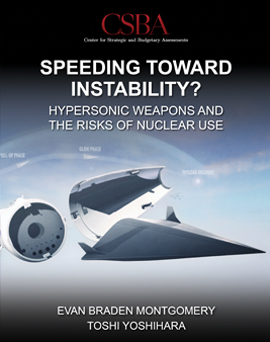Evan B. Montgomery, Toshi Yoshihara

Today, states are pursuing an array of supposedly "disruptive" or "game-changing" technologies that could alter how they organize, train, equip, and employ their forces, including their nuclear forces. The 2022 National Defense Strategy emphasized the link between some of these technologies and the risk of nuclear use, noting that "a wide range of new or fast-evolving technologies and applications are complicating escalation dynamics and creating new challenges for strategic stability."
One class of emerging military capabilities frequently cited as one such technology is hypersonic weapons: unpowered projectiles and self-propelled vehicles that can travel at greater than five times the speed of sound, follow midcourse trajectories that make detection difficult, and execute complex aerodynamic maneuvers in the terminal phase of their flight, all of which could enable them to reduce defender warning time, penetrate missile defenses, and deliver conventional or nuclear payloads against targets with a high degree of accuracy. Moreover, the United States, Russia, and China are all in various stages of developing, producing, and fielding such platforms. These developments have led to a debate over the utility, cost, and risks of hypersonic weapons.
In Speeding Toward Instability?, authors Evan Braden Montgomery and Toshi Yoshihara examine both the key drivers of nuclear escalation and the broader set of challenges facing both the conventional and nuclear balance to address the critical questions in this debate. In their analysis, they find that hypersonic weapons are not uniformly a threat to stability, and are unlikely to upset strategic stability between the United States and China in the way that critics fear they might. However, their analysis also indicates that there are wider-ranging implications of China's ongoing nuclear buildup that current assessments fail to explore. In discussing these potential escalation pathways, Montgomery and Yoshihara also assess implications for U.S. strategic policy, especially at the theater level.
No comments:
Post a Comment